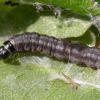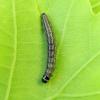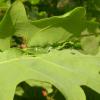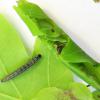35.107 Psoricoptera gibbosella (Zeller, 1839)
Status and Distribution
Local in the south and east of England and the Midlands, very local in south-west England and rare in northern England and Wales. Apparently absent from Scotland, Ireland and the Channel Islands.

Provisional map
Foodplant and Larval Feeding Signs
Quercus spp. (oak), see distribution map.
In Europe on Quercus spp. including Quercus rotundifolia (holm oak) and occasionally Salix spp. * (willows), while records from Malus (apple), Crataegus (hawthorn) and the galls of Eriophyes mites are unconfirmed, though possible.
* see note on Psoricoptera speciosella in Similar Species section below.
Feeds in a longitudinally rolled leaf.
Habitat
Mature oak woodland.
Finding the Moth
Larva: in a longitudinally rolled leaf.
Adult: comes to light and can occasionally be found resting on oak trunks.
Similar Species
Quite variable in colouration with some having prominent ammounts of white scales, giving the moth an overall pale appearance with strongly contrasting darker markings, to specimens with reduced white scaling giving the moth an overall blackish-brown appearance. In fresh specimens it is heavily adorned with raised scale tufts making it a distinctive moth but these are readily lost. At the very base of the forewing, where it touches the thorax, a blackish line can be seen in all but the very darkest specimens.
Psoricoptera speciosella, a species very similar to P. gibbosella, occurs in northern Europe to northern Italy and has been recorded in France. The moth is associated with Salix caprea (goat willow) and is slightly larger and generally blacker. However the species is variable and can have a black and white look to it but usually lacks the brownish colours present in P. gibbosella. In Scandinavia the flight period is given as later than P. gibbosella.
Single brooded from early-July to late September, rarely in June (two confirmed records) and one female (confirmed by dissection) on 31st May 2003 in Hertfordshire.
Two old records from Dorset of it having been beaten from thatch in 17th October 1864 and 19th November 1867 are exceptionally late for this species.

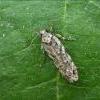

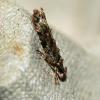
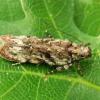

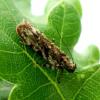
_0.jpg)
